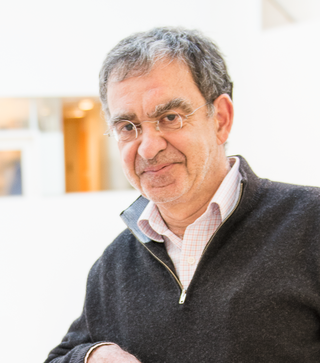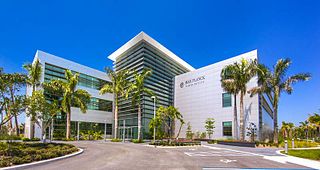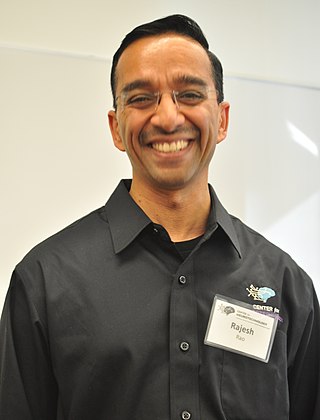Related Research Articles
Terrence Joseph Sejnowski is the Francis Crick Professor at the Salk Institute for Biological Studies where he directs the Computational Neurobiology Laboratory and is the director of the Crick-Jacobs center for theoretical and computational biology. He has performed pioneering research in neural networks and computational neuroscience.
Pendleton Read Montague, Jr. is an American neuroscientist and popular science author. He is the director of the Human Neuroimaging Lab and Computational Psychiatry Unit at the Fralin Biomedical Research Institute at VTC in Roanoke, Virginia, where he also holds the title of the inaugural Virginia Tech Carilion Vernon Mountcastle Research Professor. Montague is also a professor in the department of physics at Virginia Tech in Blacksburg, Virginia and professor of Psychiatry and Behavioral Medicine at Virginia Tech Carilion School of Medicine.

Tomaso Armando Poggio, is the Eugene McDermott professor in the Department of Brain and Cognitive Sciences, an investigator at the McGovern Institute for Brain Research, a member of the MIT Computer Science and Artificial Intelligence Laboratory (CSAIL) and director of both the Center for Biological and Computational Learning at MIT and the Center for Brains, Minds, and Machines, a multi-institutional collaboration headquartered at the McGovern Institute since 2013.

William Samuel Bialek is a theoretical biophysicist and a professor at Princeton University and The Graduate Center, CUNY. Much of his work, which has ranged over a wide variety of theoretical problems at the interface of physics and biology, centers around whether various functions of living beings are optimal, and whether a precise quantification of their performance approaches limits set by basic physical principles. Best known among these is an influential series of studies applying the principles of information theory to the analysis of the neural encoding of information in the nervous system, showing that aspects of brain function can be described as essentially optimal strategies for adapting to the complex dynamics of the world, making the most of the available signals in the face of fundamental physical constraints and limitations.
The Computation and Neural Systems (CNS) program was established at the California Institute of Technology in 1986 with the goal of training Ph.D. students interested in exploring the relationship between the structure of neuron-like circuits/networks and the computations performed in such systems, whether natural or synthetic. The program was designed to foster the exchange of ideas and collaboration among engineers, neuroscientists, and theoreticians.

The Max Planck Florida Institute for Neuroscience (MPFI), is a research facility located in Jupiter, Florida. Its research focuses on brain function and neural circuits, using techniques to visualize microscopic molecular processes. It is the first institute established by the Max Planck Society in North America.

Rajesh P. N. Rao is the Director of the NSF Center for Neurotechnology (CNT) and the Cherng Jia and Elizabeth Yun Hwang Professor of Computer Science and Engineering and Electrical and Computer Engineering at the University of Washington in Seattle.

Christoph von der Malsburg is a German physicist and neuroscientist.
The Sainsbury Wellcome Centre (SWC) is a neuroscience research institute located in London, United Kingdom. The SWC is part of University College London (UCL), but sits outside of the faculty structure. It is funded by the Gatsby Charitable Foundation and Wellcome.
Rishikesh Narayanan is an Indian neuroscientist, computer engineer and a professor at the Molecular Biophysics Unit (MBU) of the Indian Institute of Science. He is the principal investigator at the Cellular Neurophysiology Laboratory of MBU where his team is engaged in researches on experimental and theoretical aspects of information processing in single neurons and their networks. The Council of Scientific and Industrial Research, the apex agency of the Government of India for scientific research, awarded him the Shanti Swarup Bhatnagar Prize for Science and Technology, one of the highest Indian science awards, in 2016, for his contributions to biological sciences.
Lily Yeh Jan is a Taiwanese-American neuroscientist. She is the Jack and DeLoris Lange Professor of Physiology and Biophysics at the University of California, San Francisco, where she collaborates with her husband Yuh Nung Jan as co-PIs of the Jan Lab.
Anne K. Churchland is a neuroscientist at University of California, Los Angeles. Her laboratory studies the function of the posterior parietal cortex in cognitive processes such as decision-making and multisensory integration. One of her discoveries is that individual neurons in rodent posterior parietal cortex can multitask i.e. play a role in multiple behaviors. Another discovery is that rodents are similar to humans in their ability to perform multisensory integration, i.e. to integrate stimuli from two different modalities such as vision and hearing.
Yang Dan is a Chinese-American neuroscientist. She is the Paul Licht Distinguished Professor of Neurobiology at the University of California, Berkeley and a Howard Hughes Medical Institute (HHMI) Investigator. She is a past recipient of the Alfred P. Sloan Research Fellowship, Beckman Young Investigator Award, and Society for Neuroscience Research Awards for Innovation in Neuroscience. Recognized for her research on the neural circuits that control behavior, she was elected to the US National Academy of Sciences in 2018.
Tim P. Vogels is a professor of theoretical neuroscience and research leader at the Institute of Science and Technology Austria. He is primarily known for his scholarly contributions to the study of neuronal plasticity related to learning and memory in the brain.
Surya Ganguli is a university professor at Stanford University and a visiting research professor at Google. Ganguli is primarily known for his work on neural networks and deep learning, although he has also published papers on theoretical physics. He presently runs the Neural Dynamics and Computation Lab at Stanford, where he aims to reverse engineer how networks of neurons and synapses cooperate across multiple scales of space and time to facilitate sensory perception, motor control, memory, and other cognitive functions. He is also known for being a prolific public speaker and lecturer, having been invited to give over 200 talks at various universities, institutes, workshops, conferences, and symposiums since 2005.

Tatyana Sharpee is an American neuroscientist. She is a Professor at the Salk Institute for Biological Studies, where she spearheads a research group at the Computational Neurobiology Laboratory, with the support from Edwin Hunter Chair in Neurobiology. She is also an Adjunct Professor at the Department of Physics at University of California, San Diego. She was elected a fellow of American Physical Society in 2019.

Kanaka Rajan is a computational neuroscientist in the Department of Neurobiology at Harvard Medical School and founding faculty in the Kempner Institute for the Study of Natural and Artificial Intelligence at Harvard University. Rajan trained in engineering, biophysics, and neuroscience, and has pioneered novel methods and models to understand how the brain processes sensory information. Her research seeks to understand how important cognitive functions — such as learning, remembering, and deciding — emerge from the cooperative activity of multi-scale neural processes, and how those processes are affected by various neuropsychiatric disease states. The resulting integrative theories about the brain bridge neurobiology and artificial intelligence.
Tatjana Tchumatchenko is a physicist in the field of theoretical neuroscience. She is an independent Max Planck Group Leader and, since November 2020, professor for Computational Neuroscience of Behavior at the Faculty of Medicine of the Rheinische Friedrich-Wilhelms-Universität Bonn (Germany). In her research she investigates how neural networks compute and how particular activity patterns emerge from synaptic and neuronal features.
Rachel Wong is an American neuroscientist who is a professor of Biological Structure at the University of Washington. She studies the developmental mechanisms that determine synaptic connectivity in the central nervous system. She was elected to the National Vision Research Institute of Australia in 2018 and the National Academy of Sciences in 2021.
The Transmitter is an online publication dedicated to neuroscience research news and commentary. Aimed at professionals from across the neuroscience discipline, the website is an editorially-independent publication of the Simons Foundation.
References
- ↑ "Allen Institute". alleninstitute.org. Retrieved 2 February 2020.
- ↑ "Adrienne Fairhall". Simons Foundation. 25 August 2015. Retrieved 7 September 2019.
- ↑ "People". Fairhall lab. 5 September 2012. Retrieved 7 September 2019.
- ↑ "ResearchGate |". researchgate.net. Retrieved 2 February 2020.
- ↑ "Adrienne Fairhall". eScience Institute. Retrieved 7 September 2019.
- ↑ "Adrienne Fairhall on Coursera". coursera.org. Retrieved 2 February 2020.
- ↑ Mick, Jason (17 December 2013). "Top Microsoft Graphics Genius Defects to Google". DailyTech. Archived from the original on 18 December 2013.